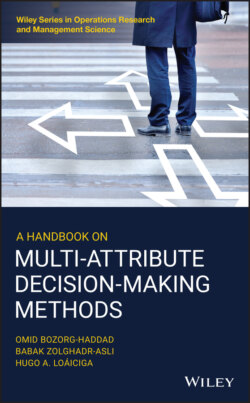A Handbook on Multi-Attribute Decision-Making Methods

Реклама. ООО «ЛитРес», ИНН: 7719571260.
Оглавление
Omid Bozorg-Haddad. A Handbook on Multi-Attribute Decision-Making Methods
Table of Contents
List of Tables
List of Illustrations
Guide
Pages
Wiley Series in Operations Research and Management Science
A Handbook on Multi‐Attribute Decision‐Making Methods
Preface
1 An Overview of the Art of Decision‐making. 1.1 Introduction
1.2 Classification of MADM Methods
1.2.1 Preference Evaluation Mechanism
1.2.2 Attributes’ Interactions
1.2.3 The Mathematical Nature of Attributes’ Values
1.2.3.1 Deterministic Vs. Nondeterministic
1.2.3.2 Fuzzy Vs. Crisp
1.2.4 Number of Involved Decision‐makers
1.3 Brief Chronicle of MADM Methods
1.4 Conclusion
References
2 Simple Weighting Methods: Weighted Sum and Weighted Product Methods. 2.1 Introduction
2.2 The Weighted Sum Method
2.2.1 Step 1: Defining the Decision‐making Problem
2.2.2 Step 2: Normalizing the Elements of the Decision‐matrix
2.2.3 Step 3: Aggregating the Preference of Alternatives
2.3 The Weighted Product Method
2.4 Conclusion
References
3 Analytic Hierarchy Process (AHP) 3.1 Introduction
3.2 The Hierarchical Structure
3.3 The Pairwise Comparison
3.4 Inconsistency
3.5 Quadruple Axioms of the AHP
3.6 Stepwise Description of the AHP Method. 3.6.1 Step 1: Defining the Decision‐making Problem
3.6.2 Step 2: Performing the Pairwise Comparison Through the Hierarchical Structure
3.6.3 Step 3: Estimating the Preference Value Vectors
3.6.4 Step 4: Synthesizing and Computing the Overall Preference Value of Alternatives
3.6.5 Step 5: Evaluating the Results’ Rationality and Selecting the Best Alternative
3.7 Conclusion
References
4 Analytic Network Process (ANP) 4.1 Introduction
4.2 Network Vs. Hierarchy Structure
4.3 Stepwise Instruction to the ANP Method
4.3.1 Step 1: Defining the Decision‐making Problem
4.3.2 Step 2: Conducting a Pairwise Comparison of the Elements of the Decision‐making Problem
4.3.3 Step 3: Forming the Supermatrix
4.3.4 Step 4: Computing the Weighted Supermatrix
4.3.5 Step 5: Computing the Global Priority Vectors and Choosing the Most Suitable Alternative
4.4 Conclusion
References
5 The Best–Worst Method (BWM) 5.1 Introduction
5.2 Basic Principles of the BWM
5.3 Stepwise Description of the BWM
5.3.1 Step 1: Defining the Decision‐Making Problem
5.3.2 Step 2: Determining the Reference Criteria
5.3.3 Step 3: Pairwise Comparisons
5.3.4 Step 4: Computing the Optimal Weights
5.3.5 Step 5: Measuring the Inconsistency of Decision‐Makers Judgments
5.4 Conclusion
References
6 TOPSIS. 6.1 Introduction
6.2 Stepwise Description of the TOPSIS Method
6.2.1 Step 1: Establishing the Formation of the Decision‐making Problem
6.2.2 Step 2: Normalizing the Element of the Decision‐matrix
6.2.3 Step 3: Computing the Weighted Normalized Preference Values
6.2.4 Step 4: Defining the Reference Alternatives
6.2.5 Step 5: Calculation of the Separation Measure
6.2.6 Step 6: Computing the Relative Closeness to the Ideal Solution
6.2.7 Step 7: Ranking the Alternatives
6.3 A Common Misinterpretation of TOPSIS Results
6.4 Conclusion
References
7 VIKOR. 7.1 Introduction
7.2 Stepwise Description of the VIKOR Method
7.2.1 Step 1: Modeling the Decision‐Making Problem
7.2.2 Step 2: Normalizing the Element of the Decision‐Matrix
7.2.3 Step 3: Compute the “Group Satisfaction” and “Individual Regret” Parameters
7.2.4 Step 4: Computing the VIKOR Parameter
7.2.5 Step 5: Ranking the Alternatives
7.2.6 Step 6: Determining the Compromise Solution
7.3 Conclusion
References
8 ELECTRE. 8.1 Introduction
8.2 A Brief History of the ELECTRE Family of Methods
8.3 ELECTRE I
8.4 ELECTRE II
8.5 ELECTRE III
8.6 ELECTRE IV
8.7 Conclusion
References
9 PROMETHEE. 9.1 Introduction
9.2 Common Ground of the PROMETHEE Family
9.2.1 Stage 1: Construction of the Generalized Criteria
9.2.2 Stage 2: Mapping the Outrank Relation on the Set of Feasible Alternatives
9.2.3 Stage 3: Evaluation the Relation Among the Feasible Alternatives
9.3 PROMETHEE I
9.4 PROMETHEE II
9.5 PROMETHEE III
9.6 PROMETHEE IV
9.7 Conclusion
References
10 Superiority and Inferiority Ranking (SIR) 10.1 Introduction
10.2 Foundational Bases of the SIR Method
10.3 Stepwise Description of the SIR Method
10.3.1 Step 1: Establishing the Formation of the Decision‐Making Problem
10.3.2 Step 2: Computing the Superiority and Inferiority Scores
10.3.3 Step 3: Forming the Superiority and Inferiority Matrices
10.3.4 Step 4: Superiority and Inferiority Flows
10.3.5 Step 5: Ranking the Set of Feasible Alternatives
10.4 Conclusion
References
11 PAPRIKA. 11.1 Introduction
11.2 Stepwise Description of PAPRIKA
11.2.1 Step 1: Defining the Decision‐Making Problem
11.2.2 Step 2: Identifying the Nondominated Pairs of Alternative
11.2.3 Step 3: Ranking the Pairs of Nondominated Solutions
11.2.4 Step 4: Calculating the Complete Ranking of Alternatives
11.3 Conclusion
References
12 Gray Relational Analysis. 12.1 Introduction
12.2 Gray System Theory: The Foundation and Basic Principles
12.3 Gray Relational Modeling
12.4 Gray Theory in Relation to MADM
12.5 Conclusion
References
A Weight Assignment Approaches
A.1 Subjective Approach: Weighted Least Squares
Objective Approach: Multiobjective Programming Model
References
B A Benchmark Example and a Comparison between Objective‐ and Subjective‐Based MADM Methods
References
Index. a
b
c
d
e
f
g
h
i
l
m
n
p
q
r
s
t
u
v
w
z
WILEY END USER LICENSE AGREEMENT
Отрывок из книги
Operations Research and Management Science (ORMS) is a broad, interdisciplinary branch of applied mathematics concerned with improving the quality of decisions and processes and is a major component of the global modern movement toward the use of advanced analytics in industry and scientific research. The Wiley Series in Operations Research and Management Science features a broad collection of books that meet the varied needs of researchers, practitioners, policy makers, and students who use or need to improve their use of analytics. Reflecting the wide range of current research within the ORMS community, the Series encompasses application, methodology, and theory and provides coverage of both classical and cutting edge ORMS concepts and developments. Written by recognized international experts in the field, this collection is appropriate for students as well as professionals from private and public sectors including industry, government, and nonprofit organization who are interested in ORMS at a technical level. The Series is comprised of four sections: Analytics; Decision and Risk Analysis; Optimization Models; and Stochastic Models.
Advisory Editors • Decision and Risk Analysis
.....
Ghiani, Laporte, and Musmanno • Introduction to Logistics Systems Management, Second Edition
Forthcoming Titles
.....